The yellow-sided green cheek conure, scientifically known as Pyrrhura molinae, is a charming and popular parrot species originating from South America. These vibrant birds are adored for their playful demeanor, striking colors, and entertaining antics. Let’s delve into the world of yellow-sided green-cheeked conures to understand their characteristics, behavior, suitability as pets, and more.
Locality and Appearance
Yellow-sided green cheek conure is native to various regions of South America, including Brazil, Argentina, Bolivia, and Paraguay. They inhabit subtropical forests and woodlands, where they display their dazzling plumage amidst lush greenery. These birds feature a predominantly green body with yellow markings on their sides, hence the name “yellow-sided.” They also boast red patches on their shoulders, blue primary flight feathers, and a tail with shades of maroon.
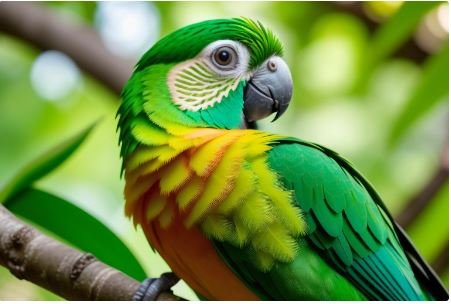
yellow-sided green cheek conure: Male vs Female
Appearance
Both male and female yellow-sided green cheek conure exhibits similar vibrant plumage. However, males typically have broader and brighter yellow markings on their sides compared to females. Additionally, males may have slightly larger heads and beaks.
Behavior
In terms of behavior, male yellow-sided green cheek conure is often more vocal and outgoing compared to females. They may display increased territorial tendencies and engage in more frequent vocalizations to assert dominance or attract a mate.
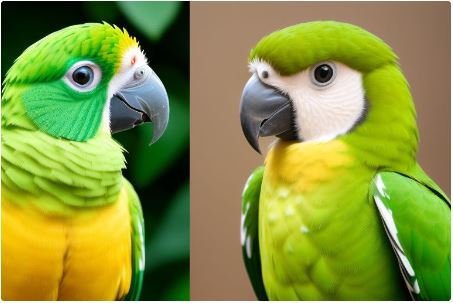
Mating
During the mating season, both male and female yellow-sided green cheek conure engage in courtship rituals characterized by mutual preening, head bobbing, and soft vocalizations. Mated pairs exhibit strong bonds and often engage in activities such as feeding and nesting together.
Dominance
In multi-bird households, dominance hierarchies may form among yellow-sided green cheeked conures. Males may assert dominance through vocalizations, posturing, and mild aggression towards other birds.
Distinctions from Other Conure Species
Yellow-sided green cheek conure possesses distinct characteristics that set them apart from other conure species such as the green cheek conure, pineapple conure, and cinnamon conure.
Appearance
While green cheek conures share similar green plumage, yellow-sided green cheek conure can be differentiated by their vibrant yellow markings on the sides. Pineapple conures exhibit a mix of yellow and orange tones, while cinnamon conures display cinnamon-colored plumage with less prominent yellow markings.
Behavior
Yellow-sided green cheek conure is known for their playful and sociable nature, often seeking interaction with humans and fellow birds. They may exhibit less aggression compared to cinnamon conures, making them suitable companions for families and novice bird owners.
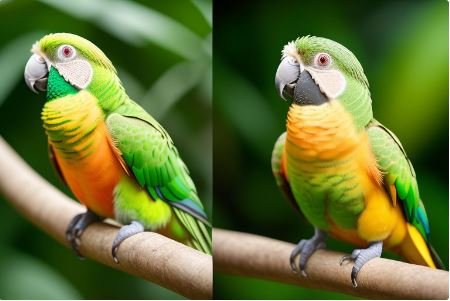
Uniqueness
What sets yellow-sided green cheeked conures apart is their delightful combination of colors, playful disposition, and remarkable intelligence. Their ability to learn tricks and mimic sounds makes them captivating pets for bird enthusiasts.
Yellow-Sided Green Cheek Conure as Pet
Yellow-sided green cheeked conures are indeed exceptional pets, offering a myriad of benefits to individuals or families seeking lively and interactive companions. Below, we delve deeper into why these charming birds are suitable for both novice and experienced bird owners:
Suitability as a Pet
- Lively Companionship: Yellow-sided green cheek conure is renowned for their vivacious personalities, bringing vibrancy and energy into any household. Their playful antics and curious nature ensure that there’s never a dull moment with these feathered friends around.
- Bonding Abilities: These conures have a remarkable capacity to form strong bonds with their human caregivers. Through consistent interaction and positive reinforcement, they quickly develop affectionate relationships, eagerly seeking out attention and affection from their human companions.
- Low Maintenance: Unlike some larger parrot species, yellow-sided green cheek conure is relatively low maintenance pet. Their small size means they require less space and fewer resources compared to larger birds, making them ideal for those living in apartments or smaller homes.
- Adaptability: One of the key reasons why yellow-sided green cheek conure makes excellent pet is their adaptability to various living situations. Whether you’re a city dweller or reside in the suburbs, these adaptable birds can thrive in different environments, provided they receive adequate care and attention.
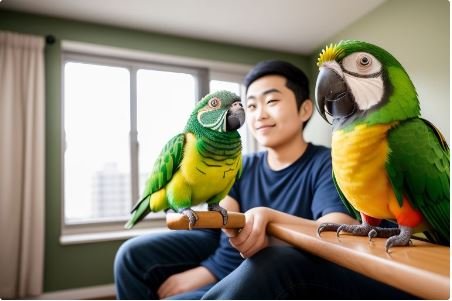
Yellow sided green cheeked conure as pet
Suitable for Beginners
- Friendly Disposition: Novice bird owners will appreciate the friendly and sociable nature of yellow-sided green cheek conure. These birds readily accept human interaction and enjoy spending time with their owners, making them easy to handle and bond with.
- Ease of Care: For beginners navigating the world of pet ownership, the relatively low maintenance requirements of yellow-sided green cheeked conures are a major advantage. With a balanced diet, regular veterinary check-ups, and plenty of social interaction, these birds can flourish under the care of novice owners.
- Adaptability to Domestic Life: Yellow-sided green cheeked conures adapt seamlessly to domestic life, blending into their human households with ease. They are not overly demanding in terms of space or environmental enrichment, making them suitable companions for individuals with varying lifestyles and schedules.
- Training Potential: Novice owners will find that yellow-sided green cheeked conures are eager learners, capable of picking up tricks and commands with relative ease. With positive reinforcement training techniques, beginners can cultivate desirable behaviors in their feathered companions, fostering a harmonious relationship built on trust and mutual understanding.
Yellow-Sided Green Cheek Conure Lifespan
Yellow-sided green cheek conure has an average lifespan of 10 to 15 years in captivity, although some individuals may live up to 20 years with proper care. In the wild, their lifespan may be shorter due to predation, habitat loss, and other environmental factors.
Factors Affecting Lifespan in Captivity
Several factors can influence the lifespan of yellow-sided green cheeked conures in captivity:
- Diet: A balanced diet rich in nutrients is essential for the health and longevity of yellow-sided green cheek conure. Inadequate nutrition can lead to various health issues and shorten their lifespan.
- Housing conditions: Providing a spacious and enriched environment is crucial for the well-being of captive conures. Proper cage size, environmental enrichment, and temperature regulation contribute to their overall health and longevity.
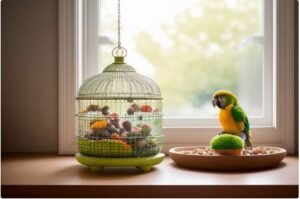
Diet and cage setup. - Veterinary care: Regular veterinary check-ups, preventive care, and prompt treatment of illnesses are vital for ensuring the health and longevity of yellow-sided green cheeked conures. Neglecting medical needs can significantly impact their lifespan.
- Social interaction: Yellow-sided green cheeked conures are social creatures that thrive on companionship and interaction. Lack of socialization and mental stimulation can lead to boredom, stress, and behavioral problems, affecting their overall well-being and lifespan.
Mortality Reasons in Captivity
The mortality rate of yellow-sided green cheek conure in captivity can be attributed to various factors, including:
- Inadequate diet leading to malnutrition and health issues.
- Poor housing conditions such as cramped cages or exposure to drafts
- Lack of veterinary care resulting in untreated illnesses or infections
- Social isolation and lack of mental stimulation leading to stress and behavioral problems.
Talking Abilities
Yellow-sided green cheek conure possesses remarkable vocal capabilities that make them fascinating companions. Here’s a closer look at their talking abilities:
Can These Talk?
While yellow-sided green cheeked conures may not match the extensive vocabulary of larger parrot species, they excel at mimicking human speech and a diverse range of sounds. Their ability to imitate words and phrases adds an entertaining dimension to their personality, captivating both novice and experienced bird owners alike.
Can Mimic Human Speech?
With patient training and consistent socialization, yellow-sided green cheek conure can develop impressive skills in mimicking human speech. Through repetition and positive reinforcement, these intelligent birds can learn to articulate words, phrases, and even sound effects with surprising accuracy.
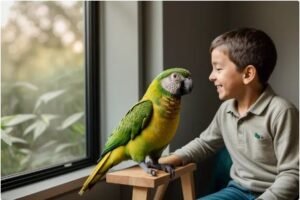
Can These Learn to Talk Words or Phrases?
Indeed, yellow-sided green cheek conure has the potential to expand their repertoire beyond mere mimicry. Through interactive sessions and engaging activities, they can grasp words, phrases, and vocalizations, infusing their conversations with personality and charm. Their eagerness to learn and interact makes them delightful companions for those seeking dynamic avian pets.
Yellow-Sided Green Cheek Conure Prices and Availability
Yellow-sided green cheek conure, prized for their vibrant colors and charming personalities, are readily available from various sources. Here’s a detailed overview of their prices and where to find them:
Prices
In the United States, yellow-sided green cheeked conures are priced between $200 to $500 on average, depending on factors such as age, color mutation, and breeder reputation. It’s important to note that prices may vary slightly based on geographical location and local market demand.
Factors Affecting Price
- Age: Younger yellow-sided green cheeked conures, particularly hand-fed chicks, tend to command higher prices due to their desirability and potential for bonding with new owners.
- Color Mutation: Variations in color mutations, such as rare mutations or visually striking combinations, can influence the price of yellow-sided green cheeked conures. Breeders may charge premium rates for birds with unique coloration.
- Breeder Reputation: Established and reputable breeders who prioritize the health and welfare of their birds often command higher prices for their yellow-sided green cheeked conures. Buyers may be willing to pay more for birds from reputable sources known for their quality and ethical breeding practices.
Where to Find Them for Sale
When looking to purchase a yellow-sided green cheek conure, it’s essential to source them from reputable and trustworthy sources to ensure the well-being of the bird. Here are some recommended avenues for finding these delightful avian companions:
- Reputable Breeders: Seek out established breeders with a track record of producing healthy and well-socialized yellow-sided green cheeked conures. Reputable breeders prioritize the health and genetic diversity of their birds, providing buyers with peace of mind.
- Avian Rescues: Consider adopting a yellow-sided green cheeked conure from a reputable avian rescue organization. Adopting from rescues not only provides a loving home for a bird in need but also supports ethical rescue and rehoming efforts.
- Specialty Pet Stores: Some specialty pet stores may carry yellow-sided green cheeked conures sourced from reputable breeders. Visit stores with knowledgeable staff who can provide guidance on bird care and welfare.
- Online Platforms: Online marketplaces like Avian Avenue and Bird Breeders may list yellow-sided green cheeked conures for sale by reputable sellers. Exercise caution and thoroughly research sellers to ensure they adhere to ethical breeding practices and prioritize bird welfare.
Pros and Cons of Having them.
Owning a yellow-sided green cheeked conure can be a rewarding experience, but it’s essential to consider both the advantages and challenges associated with caring for these vibrant birds:
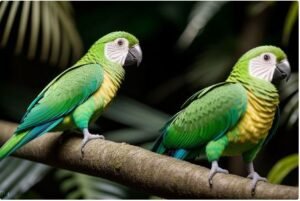
Pros:
- Affectionate and Sociable Companions: Yellow-sided green cheeked conures are known for their affectionate nature and strong bonding abilities. They thrive on social interaction and enjoy spending time with their human companions, forming deep and meaningful connections.
- Playful and Entertaining Personalities: With their playful antics and curious demeanor, yellow-sided green cheeked conures provide endless entertainment for their owners. From acrobatic displays to playful chirping, these birds bring joy and laughter into the household.
- Small Size Suitable for Indoor Living: Their compact size makes yellow-sided green cheeked conures ideal for indoor living spaces such as apartments or smaller homes. They require minimal space compared to larger parrot species, making them accessible to a wider range of bird enthusiasts.
- Potential to Learn Tricks and Mimic Sounds: Yellow-sided green cheeked conures are highly intelligent birds with a knack for learning tricks and mimicking sounds. With patience and positive reinforcement, they can master an array of behaviors and vocalizations, adding to their charm and appeal.
- Long Lifespan with Proper Care and Attention: When provided with proper care, a nutritious diet, and regular veterinary check-ups, yellow-sided green cheeked conures can live for a considerable lifespan of up to 20 years or more. Their longevity allows for enduring companionship and cherished memories.
Cons:
- Requires Regular Social Interaction and Mental Stimulation: Yellow-sided green cheeked conures thrive on social interaction and mental stimulation. They require daily interaction and engagement to prevent boredom and behavioral issues, making them unsuitable for owners with busy schedules.
- May Be Noisy at Times: Like many parrot species, yellow-sided green cheeked conures can be vocal and noisy, especially during dawn and dusk. Their calls and vocalizations may disrupt quiet environments, potentially causing disturbances for neighbors or household members.
- Needs a Balanced Diet: Maintaining a balanced diet is crucial for the health and well-being of yellow-sided green cheeked conures. They require a varied diet consisting of fresh fruits, vegetables, pellets, and occasional treats to meet their nutritional needs. Neglecting dietary requirements can lead to health problems.
- Susceptible to Health Issues: Yellow-sided green cheeked conures are prone to certain health issues, including respiratory infections and feather plucking. Owners must be vigilant about monitoring their bird’s health, providing a clean and safe environment, and seeking prompt veterinary care when needed.
- Sensitive to Environmental Changes: Yellow-sided green cheeked conures may exhibit sensitivity to environmental changes such as temperature fluctuations or disruptions in routine. Owners should strive to maintain a stable and comfortable environment to minimize stress and promote well-being.
Conclusion:
In conclusion, the yellow-sided green cheeked conure emerges as a captivating and cherished companion, renowned for its vibrant plumage, playful demeanor, and intelligence. Whether you’re a seasoned bird enthusiast or a novice pet owner, these charming parrots promise boundless joy and companionship. Their affectionate nature, small size, and ability to learn tricks make them ideal indoor pets. However, prospective owners should be prepared for regular social interaction, occasional noise, and the need for a balanced diet to ensure their well-being. Despite potential challenges, with proper care and attention, yellow-sided green cheeked conures can thrive and become beloved members of the family.
FAQs:
How long do yellow-sided green cheeked conures live?
Yellow-sided green cheeked conures have an average lifespan of 10 to 15 years in captivity, with some individuals living up to 20 years with proper care.
Do yellow-sided green cheeked conures make good pets for beginners?
Yes, yellow-sided green cheeked conures are suitable for beginners due to their friendly nature, adaptability, and relatively low maintenance requirements.
Can yellow-sided green cheeked conures talk?
While they are not known for extensive vocabulary like larger parrot species, yellow-sided green cheeked conures can learn to mimic human speech and sounds with training.
Where can I find yellow-sided green cheeked conures for sale?
Yellow-sided green cheeked conures are available for purchase from reputable breeders, pet stores, avian rescues, and online marketplaces.
What are the distinguishing features of yellow-sided green cheeked conures?
Yellow-sided green cheeked conures are characterized by their predominantly green plumage with vibrant yellow markings on their sides, red patches on their shoulders, and blue primary flight feathers.
Are yellow-sided green cheeked conures noisy pets?
While they may vocalize at times, especially during dawn and dusk, yellow-sided green cheeked conures are not excessively noisy compared to some other parrot species.
What are the differences between male and female yellow-sided green cheek conures?
While male yellow-sided green cheek conures may exhibit brighter plumage and larger size, behavioral differences between genders are minimal. Both males and females make equally affectionate and engaging pets, with individual personality traits shaping their interactions with owners.
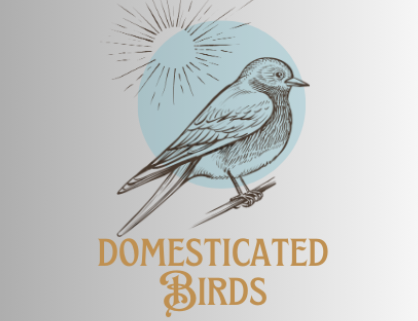
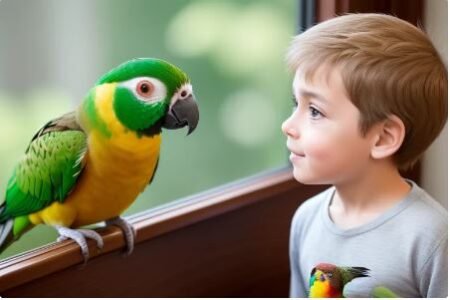
I’d like to find out more? I’d wwant to find out some additional information.
Also visit myy web site Caitlin